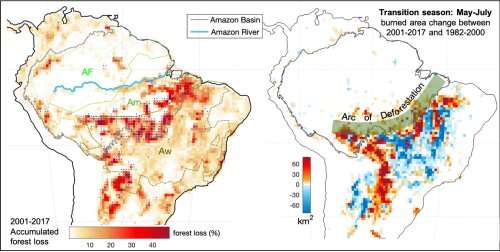Climate shift, forest loss and fires: Scientists explain how Amazon forest is trapped in a vicious circle

Amazonia experiences seasonal fires each year. More than 90% of the fires are distributed across the southern boundary of Amazon Basin where the vegetation dominated by savannas are flammable in the dry season. In recent decades, however, more fires have been reported in the Amazon forests. The 2019 Amazon fires surged to a record high.
A new study, published in Global Change Biology, showed how the fire expansion is attributed to climate regime shift and forest loss. The study was led by scientists from the Institute of Atmospheric Physics (IAP) of the Chinese Academy of Sciences.
"I have not been to the Amazon forest but I took a photo of it from my window seat when I was in a plane flying over the Amazon in 2018 fire season. It pained me to think such intense greenness and freshness might have been scorched," said Prof. Gensuo Jia from IAP, one of the authors of the study.
Global climate change and local deforestation have been blamed as main drivers behind fire intensification. "However, mechanisms and interactive effects are largely ignored and not understood," said Jia.
According to this study, the Amazon fire regime has been expanding from the flammable savannas to moist tropical forests and the fire season was initialized much earlier than two decades ago.
"The fire expansion is a result of more extreme climate events which made the forest more vulnerable. Intensive forest loss which warmed and dried the lower atmosphere therefore increased fire susceptibility," said Xiyan Xu, the first author of the study, "fire exacerbates forest loss and results in a vicious cycle."
Fire burning data derived from satellites observation indicated more fires occurring along the 'Arc of Deforestation,' a curve at the southeastern edge of the forest where deforestation is the most rapid. In the study, they used multiple satellite data products and climate reanalysis to ensure consistency and reliability.
The Amazon forest is getting dryer and more fire susceptible due to coupled changes of climate seasonality, forest loss, and wildfire. Such positive feedback greatly undermines the sustainability of Amazon region.
"Climate change mitigation and sustainable land management are key to avoid or at least postpone the 'tipping point' of the Amazon forest," said Xu. The "tipping point" is a threshold when the forest loss causes an abrupt or irreversible change in parts of the Earth system.
More information: Xiyan Xu et al, Climate regime shift and forest loss amplify fire in Amazonian forests, Global Change Biology (2020). DOI: 10.1111/gcb.15279
Journal information: Global Change Biology
Provided by Chinese Academy of Sciences





















